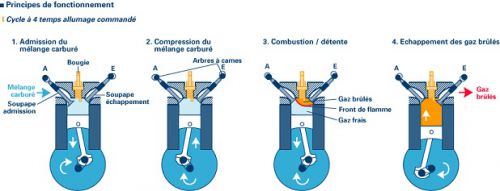PART 1:ENGINE MECHANICS
WHAT IS AN ENGINE?
Generally, we call a motor any device that provides work or mechanical energy, from natural energy such as heat or wind, or electrical energy. There are many types of engine depending on the mode of operation. .
we can define the gasoline engine, as a kind of combution device in other words, this engine transforms the heat released by the combustion of gasoline into a mechanical force to drive the vehicle.
how thermic energy is transformed into mechanical energy?
for example, the lid of a kettle begins to move when the water is heated.
the heat gained from the gas or electrical energy boils the water as well, the water vapor pushes kettle blanket.
a very important thing not to segregate, the driving force is not the result of the thermal energy but it is thanks to the air haud or the steam. It is a fluid that is necessary to transform the energy, in the case of an automobile engine the fluid is the air + fuel mixture that will be burned and repressed.
Generally, we call a motor any device that provides work or mechanical energy, from natural energy such as heat or wind, or electrical energy. There are many types of engine depending on the mode of operation. .
we can define the gasoline engine, as a kind of combution device in other words, this engine transforms the heat released by the combustion of gasoline into a mechanical force to drive the vehicle.
we can define the gasoline engine, as a kind of combution device in other words, this engine transforms the heat released by the combustion of gasoline into a mechanical force to drive the vehicle.
how thermic energy is transformed into mechanical energy?
for example, the lid of a kettle begins to move when the water is heated.
the heat gained from the gas or electrical energy boils the water as well, the water vapor pushes kettle blanket.
a very important thing not to segregate, the driving force is not the result of the thermal energy but it is thanks to the air haud or the steam. It is a fluid that is necessary to transform the energy, in the case of an automobile engine the fluid is the air + fuel mixture that will be burned and repressed.
on mardi 13 novembre 2018



